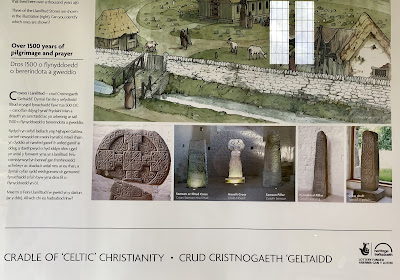While visiting Cardiff, we decided to escape to the country, or dianc i’r wlad.
Our day long guided tour included many very narrow roads and off-the-beaten path sites. Here are a few sites we visited in beautiful South Wales.
St. Lythans Burial Chambers: The region we visited is called the Vale of Glamorgan. We stopped along the side of a narrow lane, walked through a hedgerow and ambled into a cow pasture. At the top of a small hill, we spotted a burial site that predates Stonehenge. The stones that comprise the chamber are large and heavy. Surprisingly, they were somehow transported a long distance to this spot. The how and why remain a mystery. Check it out.
The Bristol Channel: Our tour included a drive along the coast of South Wales. Across the wide and treacherous Bristol Channel, we could see England. We heard stories of pirates and “breakers”, gangs who lured ships onto the rocks and stole cargo, leaving no witnesses. We walked along the rugged coast and marveled at its beauty and amazing rock formations.
Plough and Barrow: Our escape to the country included lunch at a pub in a small village. The warm fire and wood smoke made for a cozy rest and the curried chicken was tasty and very spicy.
Ewenny Priory: All over South Wales, the ruins of former monasteries and priories can be found. Most were ruined during the Dissolution of the Monasteries in the mid-1500’s. One is Ewenny Priory. Some of the buildings and surrounding walls were destroyed but the church was not. The church has a long history, predating the Norman Invasion. Below is a brief photographic tour of the church.
Below is a photo of a Norman addition to the church. When the painter J.M.W. Turner toured Wales, he painted many scenes, including the one below. His painting also appears below.
 |
| Transept of Ewenny Priory by J.M.W. Turner (1797) |
Ogmore Castle: Along with ruined monasteries, there are ruined castles in South Wales. One is Ogmore Castle that was destroyed during the English Civil War in the mid-1600’s. When we visited the ruins, the sky was gray and the air chilly, which made the experience seem more genuine.
Llanilltud: in a small village, we discovered what can be considered the cradle of Christianity for Wales, Ireland and Scotland. The site was once a religious college that taught priests who then traveled the country spreading the faith. Most of the early buildings are gone, but the church and graveyard remain.
Two features of the church were especially interesting. The stone monuments pictured below are ancient.




























No comments:
Post a Comment